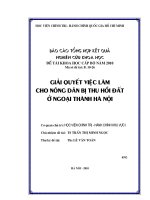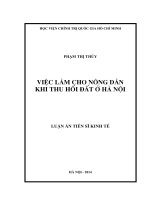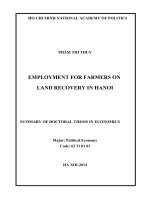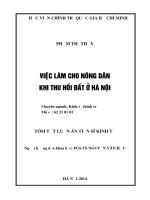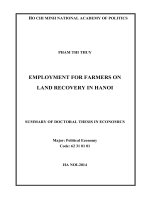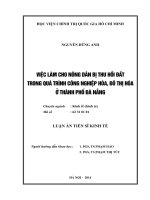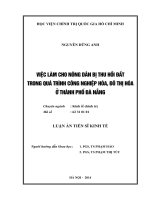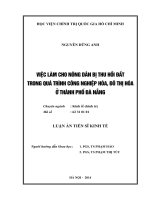tóm tắt tiếng anh việc làm cho nông dân khi thu hồi đất ở hà nội
Bạn đang xem bản rút gọn của tài liệu. Xem và tải ngay bản đầy đủ của tài liệu tại đây (116.67 KB, 26 trang )
HO CHI MINH NATIONAL ACADEMY OF POLITICS
PHAM THI THUY
EMPLOYMENT FOR FARMERS ON
LAND RECOVERY IN HANOI
SUMMARY OF DOCTORAL THESIS IN ECONOMICS
Major: Political Economy
Code: 62 31 01 01
HA NOI-2014
1
INTRODUCTION
1. Rationale
Human resources have a great role in the sustainable development of
each country, nation. The issue of human resources is very seriously
considered by the Party and it is also the basic ideas throughout the
renovation period. Vietnamese people in the new era have made
significant changes, are really passionate and creative in labor, studying,
research , which is an important contribution in creating the new face of
the country.
However, those potentials must be promoted through the production
process; one of the specific expressions is employments and socio-
economic it creates. So , the documents of the Party’s IXth National
Congress emphasize "Job creation is the determining factor to promote
human factor, stabilize and develop the economy, strengthen the society,
meet the legitimate aspirations and urgent requirements of the people."
The general trend of the industrialization process of developing
countries associated with the process of restructuring the economic sector
towards reducing the proportion of agricultural workers, increasing the
proportion of industrial and services employments. Of which, the trend of
urbanization, development of industrial zones, the new economic and
cultural centers leads to a large number of laborers losing land for
production, losing jobs and switching to other ones. This situation is
happening to the process of industrialization and modernization of
Vietnam in general and of Hanoi in particular.
The policy of socio-economic development attached to job creation
in Hanoi has had a positive impact on the demand for labor, labor market
2
development, workforce restructuring; contributed to improving the
quality of labor, the environment and more opportunities for farmers with
land recovered to find a job and settle their lives. However, the result is not
much with the pressure on employment of the City, particularly jobs for
farmers on increasing land recovery in the suburban areas under the impact
of urbanization and industrialization. In the process of restructuring,
business reorganization, a division of labor meeting the new requirements
for recruitment cannot be retrained and lose their jobs; the problem of
converting occupation, training, recovering income for laborers in land
recovery area to meet the requirements of the urbanization process is
getting more difficult, which makes the problem of job creation even more
pressing.
Therefore, the author has chosen the research topic "Employment
for farmers on land recovery in Hanoi" for the thesis paper.
2. Research objectives and mission
2.1. Research objectives
Analyze, assess the status of employments and job creation for
farmers on land recovery in Ha Noi; indicate the achievements and the
shortcomings, weakness and causes, from which propose viewpoints,
orientations and major measures to create jobs and ensure long-term stable
life for farmers on land recovery in Hanoi.
2.2. Research Tasks
+ Systematize the basic theoretical issues about employment and
jobs creation for farmers on land recovery.
3
+ Research experience of a number of localities in the country to
create jobs for farmers on land recovery and draw the lessons learnt for
Hanoi.
+ Analyze and assess the status of employment and job creation for
farmers on land recovery in Ha Noi, indicate the results achieved and
shortcomings, weakness in job creation for farmers on land recovery in
Hanoi in the recent years.
+ Propose perspective and job creation solutions to ensure long-term
stable life for farmers on land recovery in Hanoi.
3. Objects and scope of the research
3.1. Research Objects
The object of the thesis research is employments for farmers when
land is recovered in terms of political economy.
3.2. Scope of the Study
- The thesis mainly focuses on employments and job creation for
farmers on land recovery in Hanoi since 2005.
- Research and surveys location: The suburban districts of Hanoi,
especially the author conducted fieldwork in the districts of Quoc Oai, Tu
Liem, Ha Dong, Dan Phuong, Gia Lam and Ba Vi and showed the number
of agricultural labors who have lost their jobs, switched into another jobs
is very high and it’s unlikely to find new employments to guarantee their
income. So, unless this issue is solved, a lot of pressing social problems
will arise and affect the sustainable development goals of the city and the
country.
4. Rationale and Research Methods
4
4.1. Rationale
The thesis applied the Marxism - Leninism viewpoint system and the
Vietnamese Communist Party’s polices on job creation for the people
whose land is recovered. In addition, the thesis also inherits and develops
the theoretical perspectives of scientists in the country and the world on
the related content.
4.2. Research methodology
- Use the method of dialectical materialism, historical materialism,
scientific abstraction methods for analyzing reasoning and practical issues
about jobs for farmers on land recovery;
- Use statistical methods, analysis, logic combined with history, and
summary for survey and evaluation of jobs creation process for farmers on
land recovery in Hanoi;
- Inherit in a selective manner the results of previous studies and
update new information about the research topic.
5. New contributions of the thesis
Firstly, the thesis clarifies the theoretical and practical basis on
employment for farmers on land recovery.
Secondly, on the basis of analyzing, evaluating job creation process
for farmers on land recovery in Hanoi with the figures reported by the
competent authority and facts gained through questionnaire survey by the
author, the author has concluded some objective statements about the
achievements, restrictions and causes of the shortcomings in job creation
process for farmers on land recovery in Hanoi.
5
Thirdly, the author has investigated in depth the status of jobs and job
creation in some typical districts in Hanoi so that the author can offer
perspectives and propose appropriate solutions to improve the efficiency
of job creation for farmers on land recovery, achieve the targets that have
been set out by the City in job creation plans and strategies of socio-
economic development of the capital.
6. Significance of the thesis
6.1. Reasoning significance
The thesis contributes to further clarify the theoretical issues of jobs
and job creation in general and in Hanoi in particular.
6.2. Practical significance
The thesis can be used as a reference for research and teaching. The
directions and solutions proposed in the thesis may suggest the
management agencies the appropriate adjustments on job creation for the
people on land recovery in the locality today.
7. Structure of the thesis
Besides the introduction, conclusion, list of references and
appendices, the thesis consists of 4 chapters and 10 sections.
Chapter 1
OVERVIEW OF RESEARCH ON EMPLOYMENTS FOR
FARMERS ON LAND RECOVERY IN HANOI
1.1. RESEARCH SITUATION OF EMPLOYMENTS FOR
FARMERS ON LAND RECOVERY
6
1.1.1. Generalizing some overseas studies into employment
The author has studied the works by Karl Marx, JM Keynes, Harry
Toshima, EF . Schumacher and the models like classical Job Creation
Model: free competition in the market – flexible wage and full
employment; Job Creation theory by transferring employees between two
regions of the economy.
1.1.2. Some typical studies in the country into employment for
farmers on land recovery to build industrial parks and new urban
areas
The author studies related issues published in the works: books,
scientific research, theses and scientific papers.
1.2. GENERAL COMMENTS ON THE RESEARCH
SITUATION RELATED TO THE TOPIC ”EMPLOYMENTS FOR
FARMERS ON LAND RECOVERY IN VIETNAM TODAY”
1.2.1. The issues ojob creation on land recovery in Vietnam have
been resolved
All the works domestic and overseas mentioned above have covered
all issues of jobs, job creation; perspectives and solutions to job creation
for workers to improve material and spiritual life of people, to reduce
social problems arising, especially unemployment today.
During the study, the author has assessed the status of the influence,
the necessity as well as the affecting factors of land recovery on
employment for farmers whose land is acquired; on which the author has
offered some recommendations and solutions to promote the creation of
jobs for farmers whose land is recovered.
7
Each report at a particular time, with different scales, methods and
approaches have thoroughly exploited the quite colorful picture of the
actual situation of conversion of land use purpose and the issues arising. In
sum the reports also highlight the characteristics and size, as well as the
impact on socio-economic condition, life – job of the transition of land use
purpose in Vietnam recently.
1.2.2. The content on jobs and job creation for farmers on land
recovery needs further study
So far due to time and other related objective, subjective matters, the
views and solutions of previous authors have no longer suitable to the
requirements of practicality. So, this problem still requires to be
considered more and effective solutions to job creation for farmers in
Hanoi. In this direction, the thesis keeps focusing on surveys on jobs and
job creation for farmers on land recovery in Hanoi and offers solutions on
the basis of inheriting and developing the works of previous authors;
especially in the new circumstances and historical conditions of Hanoi.
Chapter 2
RATIONALE AND PRACTICES OF EMPLOYMENTS FOR
FARMERS ON LAND RECOVERY
2.1. GENERAL THEORY ON EMPLOYMENTS FOR
FARMERS ON LAND RECOVERY
2.1.1 . The concepts of job
According to some experts in the field of labor in our country,
people have different notions on employment as follows: Employees are
people who work in the fields, professions that are usefully operating and
8
not prohibited by law, providing income to feed themselves and their
families, and contributing to the society.
From the concepts, the author considers: employments are all legal
income generating activities under many different forms. Stable jobs are
the lawful income activities, commensurating with the labor spent and
stabilizing the lives of labor with safe workplace, social guarantee,
prospects for development of individuals and their families, equal
opportunities and treatment.
2.1.2. Employments of farmers and the impact of land recovery
on farmers’ employments
2.1.2.1. Farmers’ work and jobs for farmers on land recovery
According to the author, jobs for farmers on land recovery are the
economic activities that farmers after land recovery can access and use to
generate income for themselves and their families legally.
2.1.2.2. The positive impacts of land recovery on employments of
farmers
- Create more working opportunities for laborers
- Promote enhanced qualifications for employees.
- The positive impact on economic restructuring and thus on the
labor structure
2.1.2.3. The negative impacts of land recovery on employments of
farmers
- Land for agricultural cultivation is narrowed down creating
pressure on laborers.
9
- Acquisition of agricultural land increases the risk of unemployment
in the group of laborers over the age of 35.
- Due to not getting a job in rural areas after land recovery, the flow
of people into the city for jobs increases causing many negative
phenomena and potential of instability in the society.
2.2. EMPLOYMENT FOR FARMERS ON LAND RECOVERY
2.2.1. The concept of employment for farmers on land recovery
In this thesis, the author considers: Creating jobs for farmers on land
recovery is the process of creating a legal environment, necessary socio-
economic conditions, developing and implementing policies to support
training and re-training, career transformation, developing goods
production businesses and services in order to ensure legal income,
stabilize the long-term life for farmers on land recovery.
2.2.2. Content, subject and assessment criteria for outcome of job
creation for farmers on land recovery
* Content and the agent solving jobs for farmers on land recovery
- Content of job creation for farmers on land recovery includes:
+ Developing and implementing a master plan for the recovery of
agricultural land and plan to create jobs for farmers on land recovery.
+ Developing regulatory environment, necessary socio-economic
conditions to develop the labor market.
+ Developing production - business, especially those using a number
of laborers to attract agricultural labor after land recovery.
+ Developing and implementing policies to support job training ,
career transformation for workers to find employment opportunities .
10
+ Coordinate closely between the local government with the
businesses and investors using acquired land in the training and job
placement for farmers whose land is acquired.
+ Disseminating, mobilizing and helping farmers when losing their
land with actively seeking career and suitable new jobs
- The participants in job creation: employers, employees and the role
of the State.
+ Employers are the entire businesses both at home and abroad, with
the role of creating new and stable jobs for farmers who have been
working in the businesses.
+ Employees: Employees who want to have jobs must have good
health, be well-educated as well as the necessary skills to meet the
requirements of the jobs. Therefore, if workers want to have jobs, they
must constantly improve themselves in all aspects such as good health to
meet the job requirements and complete knowledge about specialized
skills.
+ The State has an important role in creating job. The role of the
State is reflected in the creation of a favorable environment for the
formation and development of jobs, creating a favorable environment for
employees as well as employers who promote their ability and issuing
policies related to employees and employers.
In addition, the social and political organizations also have an
important role in job creation for farmers after land recovery:
dissemination of the Party’s policies, laws of the State on land to farmers;
raise farmers’ awareness of the recovery of agricultural land for the benefit
of socio-economic development. In addition, such organizations as the
11
Women's Union, Farmers' Association also contribute actively in
guiding career change, looking for new jobs, and increasing income for
farmers.
* Criteria for evaluating results of jobs creation for farmers on land
recovery
- First, the ratio of rural workers after land recovery can find jobs in
industrial zones and new urban areas in the total rural labor on land
recovery.
- Second, the proportion of rural workforce supported with
vocational training, job change and the proportion of people who are
trained in accordance with the needs of the labor market in the total rural
labor on land recovery.
- Third, the proportion of the rural labor force on land recovery
without stable employments, precarious and difficult lives among the total
rural labor on land recovery.
- Fourth, the proportion of rural workers after land recovery
supported by the State in labor export to resolve employment in the total
number of rural labor on land recovery.
- Fifth, the level of coordination between local governments with
projects investors in the development and implementation of training, re-
training plans for farmers whose land is recovered in order to attract them
to work in the investment projects.
- Sixth, the implementation of policies of the Central government and
the local on job creation for farmers on land recovery.
12
2.2.3. The need to create jobs for farmers as agricultural land is
recovered
- Create jobs and contribute to stabilizing economic development
- Provide jobs to stabilize the political – social conditions.
- Provide jobs to help ease hunger eradication and poverty alleviation
2.2.4. Factors affecting employment for farmers on land recovery
- The influence of international factors:
WTO accession has brought more job opportunities for Vietnam,
especially in the direction of industrial employments; the legal barriers of
legal migration, human have been losened, economic relations, foreign
affairs, labor have contributed to attracting labor, creating jobs and
partly solving unemployment.
- The impact of domestic factors:
First, economic potentials, location and advantages of the local
Second, the ability to attract investments for economic development
and business production
Third, economic and labor restructuring
Fourth, the qualification of laborers
Fifth, the macroeconomic policies of the State.
Sixth, socio-economic development strategies of the local also have
impact on job creation for farmers after land recovery.
Seventh, the development of the labor market directly affects jobs of
employees.
13
2.3. EXPERIENCE OF A LOCAL ON EMPLOYMENT FOR
FARMERS ON LAND RECOVERY
2.3.1. The experience of Da Nang City
The City has applied the solutions to help create jobs for workers,
especially foreign workers affected by the urbanization process: loans for
running business from the Bank of Policy, national fund for job creation;
tax exemption or reduction for production and business; mobilize farmers
to farm; written regulations for businesses assigned with land in the
industrial parks in the area to be cleared to recruit the workers in the areas
affected by the urbanization process; associate with the Farmers Union of
the City to conduct investigations, surveys on the lives of households
whose land is recovered, relocated in the clearance area; classify
households’ labor resources for training plans and suitable job creation
2.3.2. The experience of Hai Duong province
Hai Duong has taken a number of basic measures to create jobs
through education - training, especially vocational training systems and
skills training for rural workers; socio-economic development, primarily
the agricultural development program towards the commodity production,
development of traditional handicraft villages to attract workers; Solve job
issues through industrial, handicraft development programs; development
of services; promote labor export.
2.3.3. The experience of Vinh Phuc
To ensure jobs for people on land recovery, conversion of land use
purpose, the Party, government, unions, businesses and people have
together implemented the solutions: promote the shift of economic
structure, especially the structure of plants and animals in the direction of
14
commodity production, creating more jobs for farmers; develop handicraft
villages, restore and develop traditional handicraft villages; encourage
farmers to contribute equity in form of land use rights to the business,
strengthening the relationship between businesses and workers; focus on
funding vocational training for students being children of household whose
land hase been recovered.
2.3.4. The lessons learned in the creation of jobs for farmers on
land recovery in Hanoi
- To help employees with the opportunity to find new jobs due to the requirements of
economic restructuring and the profession needs, must focus on the issue of training for qualified
workers through many different forms: enterprise self-training, experience transfer, vocational
training at training centers; need specific detailed plan for training, job search for farmers on land
recovery Adjust the planning progress, gentrification, build resettlement areas in accordance
with the conditions and socio-economic development of the City; have a master plan to direct
the relocation, key resettlement.
- Strengthen participation of the community, the unions, social-
political organizations in life stabilization, organize vocational training
and job creation.
- Develop economic sectors, types of economic types and promote
labor market development with emphasis on labor export to create jobs
for the people.
- Strengthen the relationship between businesses and workers for
the enterprises to issue priority policies to attract and use local labor
and landless laborers.
- Effectively use the funds from the National Fund for job creation.
These are the significant lessons learnt for Hanoi to study, apply
in a creative way to create job for farmers after land recovery in the
15
next years, when the rate of urbanization and industrialization is
getting increasingly faster, more powerful in the process of economic
development of the country.
Chapter 3
EMPLOYMENT STATUS FOR FARMERS ON LAND
RECOVERY IN HANOI
3.1. OVERVIEW OF NATURAL, SOCIO- ECONOMIC
CONDITIONS RELATED TO EMPLOYMENTS AND JOB
CREATION FOR FARMERS ON LAND RECOVERY
3.1.1. Natural conditions, geographical location of Hanoi
Hanoi is the capital of Vietnam with an important geopolitical
location and special advantages in comparison with other localities in the
country. In the region, Ha Noi is confirmed the center city with the model
of modern central urban system, major transport hubs, research centers,
financial services, trade, culture, tourism, and social infrastructure services
bearing the scope of the Southeast Asia. These factors closely connect Ha
Noi with the centers in the country and create favorable conditions to
thrive economic exchanges with the locals and foreign nations; get
involved in the process of international and regional labor division
together with the integration process of dynamic development of East Asia
– Pacific region.
3.1.2 . Socio- Economic Characteristics of Hanoi
Compared with the whole country, Hanoi is always one of the locals
having the highest rate of economic growth. Hanoi's population continues
to grow constantly. The structure of the rural labor shifts towards reducing
the proportion of agricultural labor.
16
In the years of innovation, Hanoi has strongly promoted economic
development to ensure social justice. In particular, education, training,
health care, poverty reduction, improvement of material and spiritual life
of people, reduction of negative social issues are always included in the
socio- economic development program of the City.
3.1.3. The process of agricultural land recovery in Hanoi since
2005
Hanoi is one of the locals with the highest urbanization rate.
Generally in 8 years (2000-2007), the City has had 2,725 projects
involving clearance over the areas of 13023.23 hectares and in fact has
conducted recovery and hand over 7274.661 hectares of agricultural
recovered land for investors.
Until 2011, in the city of Hanoi there have been 1,090 investment
projects related to land recovery, with the land recovery scale up to
10,574ha; involving more than 190,066 organizations, households and
individuals; expected to arrange resettlement for over 17,087 households.
3.2. EMPLOYMENT STATUS AND JOB CREATION FOR
FARMERS IN HANOI ON AGRICULTURAL LAND RECOVERY
3.2.1. Current status of employment for rural labor in Hanoi
The number of residents of rural areas in Hanoi occupies a large
proportion in comparison with the whole city, in 2010 it was 3801.4
thousand people (62%) were stable distribution in the district of Hanoi (see
appendix table 6). The quality of labor in agriculture and rural sector is
still low. By 2011 in Hanoi, the unemployment rate of labor without
technical expertise in rural areas remained high (83.7%). This reduced the
17
adaptability, job seeking ability of people was low and the risk of
unemployment was very high.
3.2.2. Employment situation for farmers after land recovery in
Hanoi
The author has analyzed the situation of jobs for farmers after land
recovery in Hanoi: The shift of business production activities and
occupation of the employees; Attracting workforce from enterprises; The
effectiveness of training activities; The support from the Central
government and Hanoi to create employments; Operations of the job
service centers and labor export activities.
3.3. OVERALL ASSESSMENT OF EMPLOYMENT FOR
FARMERS ON LAND RECOVERY IN HANOI RECENTLY
3.3.1. The results of job creation for farmers on land recovery in
Hanoi
With much effort and various measures of the Party Committee, the
City government, local businesses and the workers themselves, in the
recent years Hanoi has created a lot of achievements in the field of job
creation for labor in general and for farmers in particular after the land
recovery. This fact shows:
- Hanoi has attracted a significant number of local employees to
work in the industrial parks and clusters
- The city has several policies, programs and projects in order to
create various favorable conditions and opportunities for farmers whose
land is acquired to find a new job
18
- Vocational training activities in the City has gained certain
achievements contributing to help labor find jobs.
3.3.2. The limitations, weaknesses and cause of limitations in
creating jobs for farmers on land recovery in Hanoi
Firstly, the number of people whose land is recovered attracted to
work in the businesses, industrial parks accounts for a very low percentage
compared to the total number of employees losing their jobs.
Secondly, unemployment, underemployment remains high
percentage.
Thirdly, the number of farmers switching to new industries is low;
the quality, stability and sustainability of jobs for farmers after land
recovery is not high
Fourthly, labor export results is low (only accounted for 2% of the
total labor getting jobs annually).
Fifthly, the operation of the employment service centers are not
really effective.
Sixthly, policies and implementation of the State and the City
policies in job creation for farmers on land recovery is asynchronous and
not radical.
Seventhly, the organization of vocational training for farmers on land
recovery is not studied thoroughly, leading to trained occupation is not
appropriate with the needs of the labor market, so, even though employees
have been trained, they cannot find a job.
19
Eighthly, businesses using recovered agricultural land haven’t
implemented well their commitment of giving priority to local labor with
land recovered on recruitment.
Ninethly, the preparation of the locals and people in job creation after
land recovery is not really synchronous, making it difficult for people,
especially rural people to stabilize their lives.
Chapter 4
DIRECTION AND EMPLOYMENT SOLUTIONS FOR FARMERS
ON LAND RECOVERY IN HANOI
4.1. FORECAST FOR LAND RECOVERY AND VIEWPOINTS
ON JOB CREATION FOR FARMERS IN HANOI ON
AGRICULTURAL LAND RECOVERY
4.1.1. Forecast of land recovery and employment needs of
farmers on the recovery of land in Hanoi by 2020
According to the land use planning of Hanoi by 2020, the land use
plan in the period 2010-2015, in the period from 2010 to 2015 the area of
agricultural land will decrease by 11.6 thousand hectares to switch to the
non-agricultural purposes, and will continue to decline 25,218.9 hectares
in 2020, reducing the area of agricultural land in Hanoi down to 151,779.9
hectares only. Thus, in the coming years, the agricultural land area in
Hanoi will decrease over 36,000 ha. Based on calculations of the Ministry
of Labour - Invalids and Social Welfare once each hectare of agricultural
land is revoked, 13 people will lose their jobs. This means in the coming
time in Hanoi approximately 468,000 farmers will lose their jobs due to
land recovery. This will greatly impact the balance of jobs supply -
20
demand and create pressure for the city in job creation for the people
whose agricultural land is revoked.
4.1.2. The viewpoint of job creation for farmers on land
recovery in Ha Noi:
Firstly, ensuring stable, reasonable and sustainable job, incomes to
enhance and improve the lives of farmers after land recovery is an
important task in socio-economic development plan of the Capital City;
Secondly, the city creates favorable environment and implements
macro-control to ensure employments, income and livelihood for farmers
after land recovery;
Thirdly, must consider job, income and livelihoods guarantee for
farmers after land recovery the responsibility of the entire social-political
system, businesses and all people concerned; promote the autonomy of
people in vocational training, self-employment and labor market
participation;
Fourthly, implement employment diversity and job-site attention,
especially in agriculture and rural development;
Fifthly, resolve key jobs for those with employment needs; job
creation measures need to be synchronous, and comprehensive.
4.2. EMPLOYMENT SOLUTIONS FOR FARMERS ON LAND
RECOVERY IN HANOI
4.2.1. Encourage the development of diverse forms of business
organization to create jobs
- Facilitate the development and expansion of small and medium
sized businesses to attract workers;
21
- Encourage business development in industrial parks and clusters to
attract more local workers
- Promote the development of handicraft villages and traditional
industries to create jobs
- Encourage the development of the farm economy, tourism, services
and household economic
4.2.2. Enhance qualification and activeness of farmers in
searching for jobs
- Develop and enhance the effectiveness of vocational training for
workers
- Improve farmers' dynamism in order to create, search for jobs, raise
incomes for themselves and their families after agricultural land recovery
4.2.3. Development and expansion of the labor market
- Disseminate information widely on employment for rural workers
timely access to employment needs in society
- Strongly develop the employment service centers towards
improving operation quality to create favorable conditions for laborers to
find work
- To promote labor exports to create jobs
4.2.4. Solutions to improve the efficiency of the State’s
management in the settlement of employment for farmers on land
recovery
- Enhance capacity, leadership and management of the State for the
implementation of job creation targets.
22
- Regularly evaluate the effectiveness of the socio- economic
assessment of social policies supporting job transformation, job creation
for farmers on land recovery to constantly improve those policies.
- Improve operational efficiency of planning and land use plan
4.2.5. Implement economic links to develop production and
attract labor
Economic links satisfy the three requirements of providing capital,
technology, and creating markets for smallholder farmers, thereby create
and maintain the ability to reproduce and expansion of the rural
households and reproductive contribution to businesses.
CONCLUSION
Based on the theoretical and practical issues on employments for
farmers on land recovery in Hanoi, the thesis has basically concluded the
followings:
1. Employments are all legal income generating activities under
many different forms. Stable jobs are the lawful income activities,
commensurating with the labor spent and stabilizing the lives of labor with
safe workplace, social guarantee, prospects for development of individuals
and their families, equal opportunities and treatment.
Jobs for farmers on land recovery are activities that farmers after
land recovery can access and use to create a legitimate source of income
for themselves and their families.
2. Job creation for farmers on land recovery is the process of creating
a legal environment, necessary socio-economic conditions, building and
23
implementing policies to support training and re-training, career
transformation, development of production and trading of goods and
services to ensure legitimate income, long- term life stability for farmers
on land recovery.
3. The major achievements and limitations in jobs creation for
farmers on land recovery in Hanoi are as follows: Results: a number of
farmers have found their jobs to partly stabilize the economic - political –
social conditions and ensure legitimate incomes as well as stable lives;
Limitations: The number of people whose land is recovered attracted to
work in the business, industrial parks accounts for a very low percentage
compared to the total number of employees who lost their jobs;
Unemployment and employment shortage remains high percentage; The
quality, stability and sustainability of employments for farmers after land
recovery is not high; The organization of vocational training for farmers
on land recovery is not studied thoroughly, leading to trained occupation is
not appropriate with the needs of the labor market, so, even though
employees have been trained, they cannot find a job
4. The viewpoint of job creation for farmers on land recovery: (1).
Ensuring stable, reasonable and sustainable job, incomes to enhance and
improve the lives of farmers after land recovery is an important task in
socio-economic development plan of the Capital City; (2). The city creates
favorable environment and implements macro-control to ensure
employments, income and livelihood for farmers after land recovery (3).
Must consider job, income and livelihoods guarantee for farmers after land
recovery the responsibility of the entire social-political system, businesses
and all people concerned; promote the autonomy of people in vocational
training, self-employment and labor market participation; (4). Implement
24
employment diversity and job-site attention, especially in agriculture and
rural development; (5). Resolve key jobs for those with employment
needs; job creation measures need to be synchronous, and comprehensive.
5. To create jobs for farmers on agricultural land recovery, should
perform the following solutions synchronously: (1). Encourage the
development of diverse forms of business organizations to address job; (2).
Enhance qualification and activeness of farmers in searching for jobs; (3).
Development and expansion of the labor market; (4). Solutions to improve
the efficiency of the State’s management in the settlement of employment
for farmers on land recovery; (5). Implement economic links to develop
production and attract labor.

